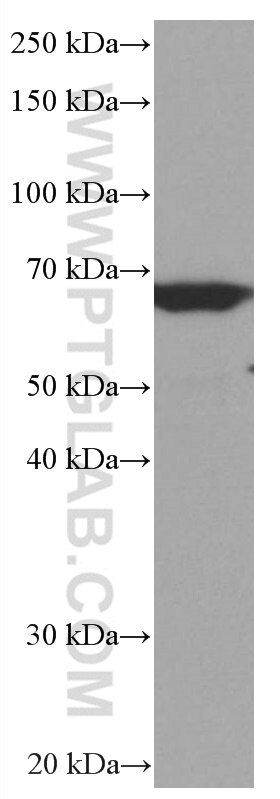Validation Data Gallery
Filter:
Tested Applications
| Positive WB detected in | Raji cells |
Recommended dilution
| Application | Dilution |
|---|---|
| Western Blot (WB) | WB : 1:1000-1:4000 |
| It is recommended that this reagent should be titrated in each testing system to obtain optimal results. | |
| Sample-dependent, Check data in validation data gallery. | |
Published Applications
| WB | See 1 publications below |
Product Information
66947-1-Ig targets RELB in WB, ELISA applications and shows reactivity with Human samples.
| Tested Reactivity | Human |
| Cited Reactivity | human |
| Host / Isotype | Mouse / IgG1 |
| Class | Monoclonal |
| Type | Antibody |
| Immunogen | RELB fusion protein Ag13824 相同性解析による交差性が予測される生物種 |
| Full Name | v-rel reticuloendotheliosis viral oncogene homolog B |
| Calculated molecular weight | 62 kDa |
| Observed molecular weight | 62-65 kDa |
| GenBank accession number | BC028013 |
| Gene Symbol | RELB |
| Gene ID (NCBI) | 5971 |
| RRID | AB_2882271 |
| Conjugate | Unconjugated |
| Form | Liquid |
| Purification Method | Protein G purification |
| UNIPROT ID | Q01201 |
| Storage Buffer | PBS with 0.02% sodium azide and 50% glycerol{{ptg:BufferTemp}}7.3 |
| Storage Conditions | Store at -20°C. Stable for one year after shipment. Aliquoting is unnecessary for -20oC storage. |
Background Information
RELB, also named as Transcription factor RelB, is a 579 amino acid protein, which contains one RHD domain. RELB localizes in the nucleus and cytoplasm. RELB is a pleiotropic transcription factor which is present in almost all cell types and is involved in many biological processed such as inflammation, immunity, differentiation, cell growth, tumorigenesis and apoptosis.
Protocols
| Product Specific Protocols | |
|---|---|
| WB protocol for RELB antibody 66947-1-Ig | Download protocol |
| Standard Protocols | |
|---|---|
| Click here to view our Standard Protocols |
Publications
| Species | Application | Title |
|---|---|---|
